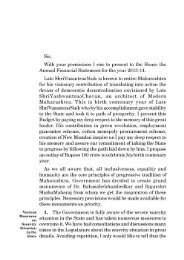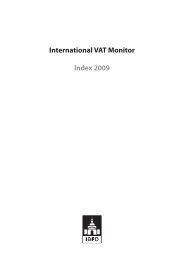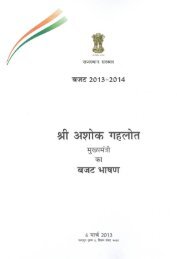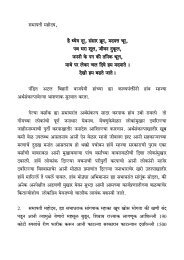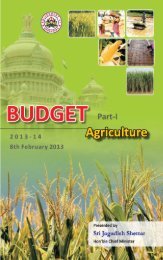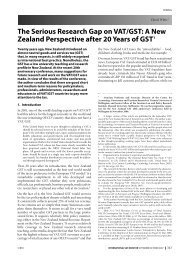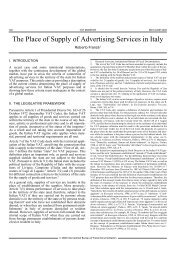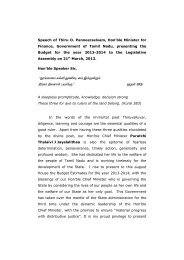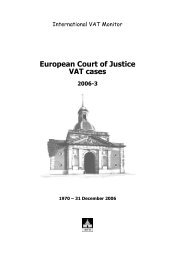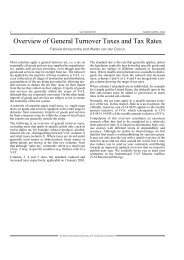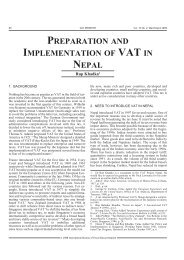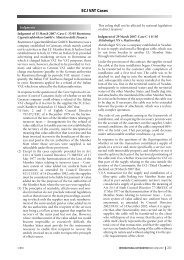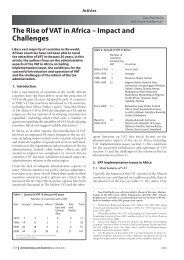Calculation of the (Pre-) Pro Rata under EU VAT Law - empcom.gov.in
Calculation of the (Pre-) Pro Rata under EU VAT Law - empcom.gov.in
Calculation of the (Pre-) Pro Rata under EU VAT Law - empcom.gov.in
You also want an ePaper? Increase the reach of your titles
YUMPU automatically turns print PDFs into web optimized ePapers that Google loves.
Mandy Gabriël and Herman van Kesteren<br />
<strong>Calculation</strong> <strong>of</strong> <strong>the</strong> (<strong>Pre</strong>-) <strong>Pro</strong> <strong>Rata</strong> <strong>under</strong><br />
<strong>EU</strong> <strong>VAT</strong> <strong>Law</strong><br />
Where taxable persons use <strong>in</strong>puts for taxed<br />
and exempt purposes, <strong>the</strong>y have to attribute<br />
<strong>the</strong> costs <strong>of</strong> <strong>the</strong> <strong>in</strong>puts to both categories <strong>of</strong><br />
transactions, commonly on <strong>the</strong> basis <strong>of</strong> a “pro<br />
rata” calculation. In this article, <strong>the</strong> authors<br />
analyse <strong>the</strong> ECJ’s decision <strong>in</strong> Securenta, <strong>in</strong> which<br />
<strong>the</strong> ECJ seems to have presented a new scenario,<br />
i.e. <strong>the</strong> method for determ<strong>in</strong><strong>in</strong>g <strong>the</strong> rate <strong>of</strong><br />
deduction <strong>in</strong> respect <strong>of</strong> <strong>in</strong>puts used by taxable<br />
persons for <strong>the</strong> purposes <strong>of</strong> carry<strong>in</strong>g out both<br />
economic and non-economic activities, which<br />
<strong>the</strong> authors label as “pre-pro rata”. The article<br />
is followed by several comments made by Paul<br />
Lasok to <strong>the</strong> authors’ conference paper.<br />
1. Introduction<br />
Under Art. 9 <strong>of</strong> <strong>the</strong> <strong>VAT</strong> Directive, 1 any person who,<br />
<strong>in</strong>dependently, carries out <strong>in</strong> any place any economic activity<br />
qualifies as a taxable person, whatever <strong>the</strong> purpose<br />
or results <strong>of</strong> that activity. The taxable person’s economic<br />
activities can be fully taxed or fully exempt, or specific<br />
activities may be taxed whereas o<strong>the</strong>rs are exempt. However,<br />
<strong>the</strong> activities <strong>of</strong> taxable persons are not limited to<br />
economic activities. Taxable persons can also carry out<br />
non-economic activities, i.e. activities that are outside <strong>the</strong><br />
scope <strong>of</strong> (<strong>EU</strong>) <strong>VAT</strong>.<br />
Establish<strong>in</strong>g <strong>the</strong> nature <strong>of</strong> <strong>the</strong> outgo<strong>in</strong>g transactions is<br />
necessary for <strong>the</strong> purpose <strong>of</strong> determ<strong>in</strong><strong>in</strong>g whe<strong>the</strong>r and,<br />
if so, to what extent, taxable persons can deduct <strong>VAT</strong><br />
charged to <strong>the</strong>m on <strong>the</strong> purchase <strong>of</strong> goods and services. 2<br />
In pr<strong>in</strong>ciple, taxable persons are entitled to deduct that<br />
<strong>VAT</strong> <strong>in</strong> so far as <strong>the</strong>y use <strong>the</strong> goods and services for <strong>the</strong><br />
purposes <strong>of</strong> carry<strong>in</strong>g out taxed transactions. 3 Where<br />
<strong>the</strong>y use <strong>the</strong> <strong>in</strong>puts for both taxed and exempt purposes,<br />
taxable persons have to attribute <strong>the</strong> costs <strong>of</strong> <strong>the</strong> <strong>in</strong>puts<br />
to both categories <strong>of</strong> transactions, ei<strong>the</strong>r by directly attribut<strong>in</strong>g<br />
<strong>the</strong> <strong>in</strong>puts to specific output transactions or<br />
by attribut<strong>in</strong>g <strong>the</strong>m to <strong>the</strong>ir total economic activities by<br />
reference to turnover derived from <strong>the</strong> two categories <strong>of</strong><br />
transactions. In <strong>the</strong> latter case, <strong>the</strong> deductible proportion<br />
is commonly based on a “pro rata” calculation.<br />
It follows from case law <strong>of</strong> <strong>the</strong> Court <strong>of</strong> Justice <strong>of</strong> <strong>the</strong><br />
European Union (ECJ) that, contrary to a literal <strong>in</strong>terpretation<br />
<strong>of</strong> Art. 174 <strong>of</strong> <strong>the</strong> <strong>VAT</strong> Directive, only <strong>in</strong>come<br />
(“turnover”) derived from economic activities can be<br />
taken <strong>in</strong>to account for <strong>the</strong> purposes <strong>of</strong> calculation <strong>of</strong> <strong>the</strong><br />
pro rata. This view <strong>of</strong> <strong>the</strong> ECJ has given rise to several<br />
questions, which should be, but have not yet fully been,<br />
answered by <strong>the</strong> ECJ. In respect <strong>of</strong> non-economic activities,<br />
<strong>the</strong> pro rata mechanism is not completely sidel<strong>in</strong>ed:<br />
332<br />
European Union<br />
Mandy Gabriël<br />
and Herman van Kesteren*<br />
where <strong>the</strong> taxable person’s economic activities benefit<br />
from non-economic activities and <strong>the</strong> costs <strong>of</strong> <strong>the</strong> <strong>in</strong>puts<br />
relat<strong>in</strong>g to <strong>the</strong> non-economic activities can be l<strong>in</strong>ked to<br />
<strong>the</strong> totality <strong>of</strong> economic activities, <strong>the</strong> pro rata calculation<br />
still applies. 4<br />
One <strong>of</strong> <strong>the</strong> unanswered questions results from <strong>the</strong> ECJ’s<br />
judgment <strong>in</strong> Securenta. 5 On that occasion, <strong>the</strong> ECJ seems<br />
to have presented a new scenario – “new” <strong>in</strong> <strong>the</strong> sense<br />
that it is not expressly covered by <strong>the</strong> currently exist<strong>in</strong>g<br />
provisions <strong>of</strong> <strong>the</strong> <strong>VAT</strong> Directive, i.e. <strong>the</strong> method for determ<strong>in</strong><strong>in</strong>g<br />
<strong>the</strong> rate <strong>of</strong> deduction <strong>in</strong> respect <strong>of</strong> <strong>in</strong>puts used<br />
by taxable persons for <strong>the</strong> purposes <strong>of</strong> carry<strong>in</strong>g out both<br />
economic and non-economic activities. Accord<strong>in</strong>g to <strong>the</strong><br />
ECJ, it is up to <strong>the</strong> Member States to establish to that end<br />
appropriate methods and criteria, which must be consistent<br />
with <strong>the</strong> pr<strong>in</strong>ciples <strong>under</strong>ly<strong>in</strong>g <strong>the</strong> common system <strong>of</strong><br />
<strong>VAT</strong>. It is clear from <strong>the</strong> ECJ’s judgment <strong>in</strong> Securenta that<br />
that method for apportion<strong>in</strong>g <strong>in</strong>put <strong>VAT</strong> must be applied<br />
before application <strong>of</strong> <strong>the</strong> exist<strong>in</strong>g pro rata. It can <strong>the</strong>refore<br />
be labelled as “pre-pro rata”.<br />
In order to correctly calculate <strong>the</strong> pre-pro rata, more<br />
guidel<strong>in</strong>es or rules are required and also <strong>the</strong> ECJ’s judgment<br />
<strong>in</strong> SKF6 may affect <strong>the</strong> new rules. <strong>Pre</strong>viously, <strong>the</strong><br />
ECJ tended to treat sales <strong>of</strong> shares by hold<strong>in</strong>g companies<br />
as non-economic activities. 7 However, <strong>in</strong> its judgment <strong>in</strong><br />
SKF, <strong>the</strong> ECJ held (on <strong>the</strong> basis <strong>of</strong> <strong>the</strong> “extension <strong>the</strong>ory”)<br />
that <strong>the</strong> disposal <strong>of</strong> shares <strong>in</strong> a subsidiary by a hold<strong>in</strong>g<br />
company that is <strong>in</strong>volved <strong>in</strong> <strong>the</strong> management <strong>of</strong> that<br />
subsidiary can constitute an economic activity, which is<br />
exempt from <strong>VAT</strong>. This fairly surpris<strong>in</strong>g view may also<br />
have an important impact on <strong>the</strong> pre-pro rata and pro<br />
rata fractions.<br />
* Mandy M. Gabriël is an Indirect Taxes Consultant for PricewaterhouseCoopers<br />
E<strong>in</strong>dhoven and a PhD researcher at Maastricht University.<br />
Herman W.M. van Kesteren is an Indirect Taxes Partner at<br />
PricewaterhouseCoopers Amsterdam, a pr<strong>of</strong>essor <strong>of</strong> <strong>in</strong>direct taxation<br />
at Tilburg University and a judge <strong>in</strong> ’s-Hertogenbosch and The Hague.<br />
1. Council Directive 2006/112/EC <strong>of</strong> 28 November 2006 on <strong>the</strong> common<br />
system <strong>of</strong> value added tax, OJ L 347 <strong>of</strong> 11 December 2006.<br />
2. Hereafter referred to as “<strong>in</strong>put <strong>VAT</strong>”.<br />
3. Art. 168 <strong>of</strong> <strong>the</strong> <strong>VAT</strong> Directive.<br />
4. ECJ judgments <strong>of</strong> 27 September 2001 <strong>in</strong> Cibo Participations SA v. Directeur<br />
régional des impôts du Nord-Pas-de-Calais, Case C-16/00, [2001] ECR<br />
I-6663; and <strong>of</strong> 26 May 2005 <strong>in</strong> Kretztechnik AG v. F<strong>in</strong>anzamt L<strong>in</strong>z, Case<br />
C-465/03, [2005] ECR I-4357.<br />
5. ECJ judgment <strong>of</strong> 13 March 2008 <strong>in</strong> Securenta Gött<strong>in</strong>ger Immobilienanlagen<br />
und Vermögensmanagement AG v. F<strong>in</strong>anzamt Gött<strong>in</strong>gen, Case C-437/06,<br />
[2008] ECR I-1597, Para. 34.<br />
6. ECJ judgment <strong>of</strong> 29 October 2009 <strong>in</strong> Skatteverket v. AB SKF, Case C-29/08,<br />
[2009] ECR I-10413.<br />
7. At least, <strong>in</strong> so far as <strong>the</strong> activities are not comparable to those <strong>of</strong> a commercial,<br />
pr<strong>of</strong>essional share dealer. See also ECJ judgment <strong>of</strong> 14 November<br />
2000 <strong>in</strong> Floridienne SA and Berg<strong>in</strong>vest SA v. Belgian State, Case C-142/99,<br />
[2000] ECR I-9567, Para. 28.<br />
INTERNATIONAL <strong>VAT</strong> MONITOR SEPTEMBER/OCTOBER 2011 © IBFD
2. Right to Deduct Input Tax<br />
In order to safeguard <strong>the</strong> neutrality <strong>of</strong> <strong>the</strong> <strong>VAT</strong> system,<br />
<strong>the</strong> <strong>VAT</strong> Directive conta<strong>in</strong>s a set <strong>of</strong> rules on <strong>the</strong> right<br />
to deduct <strong>in</strong>put <strong>VAT</strong>. This deduction system is aimed<br />
at entirely reliev<strong>in</strong>g taxable persons <strong>of</strong> <strong>the</strong> <strong>VAT</strong> paid or<br />
payable <strong>in</strong> <strong>the</strong> framework <strong>of</strong> all <strong>the</strong>ir economic activities,<br />
provided that <strong>the</strong>se activities are subject to <strong>VAT</strong>. 8 The<br />
right to deduct may not <strong>in</strong> pr<strong>in</strong>ciple be limited and must<br />
be exercised immediately <strong>in</strong> respect <strong>of</strong> all <strong>VAT</strong> charged<br />
on transactions relat<strong>in</strong>g to <strong>in</strong>puts. 9<br />
The transactions <strong>of</strong> taxable persons are rarely fully taxed<br />
or fully exempt – <strong>the</strong>ir output is frequently a comb<strong>in</strong>ation<br />
<strong>of</strong> taxed and exempt transactions – and <strong>the</strong> purposes<br />
for which taxable persons make specific <strong>in</strong>vestments and<br />
purchase o<strong>the</strong>r <strong>in</strong>puts may vary widely. Specific <strong>in</strong>puts<br />
may be directly attributable to taxed transactions and o<strong>the</strong>rs<br />
only to exempt transactions. For <strong>the</strong> purposes <strong>of</strong> direct<br />
attribution, <strong>the</strong> <strong>in</strong>puts must have a direct and immediate<br />
l<strong>in</strong>k with a subsequent taxable transaction; <strong>the</strong> ultimate<br />
aim pursued by <strong>the</strong> taxable person by carry<strong>in</strong>g out that<br />
transaction is irrelevant. 10<br />
Where particular <strong>in</strong>puts are directly attributable to particular<br />
output transactions, <strong>the</strong> entitlement to deduct <strong>the</strong><br />
related <strong>VAT</strong> is based on Art. 168 <strong>of</strong> <strong>the</strong> <strong>VAT</strong> Directive.<br />
Where <strong>the</strong> acquired goods and services are used for both<br />
taxed and exempt transactions, <strong>the</strong> <strong>in</strong>puts do not necessarily<br />
have to be attributed to <strong>in</strong>dividual output transactions.<br />
If <strong>the</strong> costs <strong>of</strong> <strong>the</strong> <strong>in</strong>puts are part <strong>of</strong> <strong>the</strong> general overhead<br />
costs and are, as such, components <strong>of</strong> <strong>the</strong> prices <strong>of</strong><br />
<strong>the</strong> output transactions, <strong>the</strong> related <strong>VAT</strong> can be deducted<br />
on <strong>the</strong> basis <strong>of</strong> <strong>the</strong> pro rata. 11<br />
Thus far, <strong>the</strong>re are obviously three options: <strong>the</strong> <strong>in</strong>puts can<br />
be attributed to <strong>the</strong> taxable person’s taxed transactions, to<br />
its exempt transactions or to its economic bus<strong>in</strong>ess activities<br />
as a whole. In <strong>the</strong> latter case, a proportional division<br />
<strong>in</strong>to deductible and non-deductible <strong>in</strong>put tax is required.<br />
This is where <strong>the</strong> rules <strong>gov</strong>ern<strong>in</strong>g “partial deduction”<br />
come <strong>in</strong>to play. 12 These rules, however, only apply with<br />
regard to economic activities. 13<br />
3. Partial Deduction <strong>in</strong> Respect <strong>of</strong> Economic<br />
Activities<br />
3.1. The pro rata mechanism<br />
The rules on partial or proportional deduction <strong>of</strong> <strong>VAT</strong><br />
laid down by <strong>the</strong> <strong>VAT</strong> Directive prevent <strong>the</strong> costs <strong>of</strong><br />
<strong>the</strong> <strong>in</strong>puts hav<strong>in</strong>g to be attributed to <strong>in</strong>dividual output<br />
transactions. Where taxable persons purchase goods or<br />
services for <strong>the</strong> benefit <strong>of</strong> <strong>the</strong>ir overall bus<strong>in</strong>ess activities,<br />
<strong>the</strong> related costs are “general costs” or “overheads”.<br />
On <strong>the</strong> basis <strong>of</strong> <strong>the</strong> <strong>VAT</strong> Directive, <strong>the</strong> deductible proportion<br />
<strong>of</strong> <strong>the</strong> <strong>VAT</strong> on a taxable person’s overheads is<br />
to be determ<strong>in</strong>ed by apply<strong>in</strong>g a s<strong>in</strong>gle fraction based on<br />
turnover proportions. Member States may deviate from<br />
this rule and authorize or require taxable persons to determ<strong>in</strong>e<br />
multiple proportions, such as proportions relat<strong>in</strong>g<br />
to separate parts <strong>of</strong> <strong>the</strong>ir bus<strong>in</strong>esses. They may also<br />
authorize or require taxable persons to determ<strong>in</strong>e <strong>the</strong><br />
<strong>Calculation</strong> <strong>of</strong> <strong>the</strong> (<strong>Pre</strong>-) <strong>Pro</strong> <strong>Rata</strong> <strong>under</strong> <strong>EU</strong> <strong>VAT</strong> <strong>Law</strong><br />
rate <strong>of</strong> deduction <strong>of</strong> <strong>in</strong>put <strong>VAT</strong> on <strong>the</strong> basis <strong>of</strong> actual use<br />
<strong>of</strong> <strong>the</strong> <strong>in</strong>puts. 14<br />
The numerator <strong>of</strong> <strong>the</strong> turnover (“pro rata”) fraction15 consists<br />
<strong>of</strong> turnover derived from taxed transactions, and <strong>the</strong><br />
denom<strong>in</strong>ator <strong>of</strong> total turnover (derived from taxed and<br />
exempt transactions).<br />
3.2. Turnover to be taken <strong>in</strong>to account<br />
Member States may <strong>in</strong>clude subsidies o<strong>the</strong>r than subsidies<br />
directly l<strong>in</strong>ked to <strong>the</strong> price <strong>of</strong> goods or services <strong>in</strong><br />
<strong>the</strong> denom<strong>in</strong>ator <strong>of</strong> <strong>the</strong> pro rata fraction, 16 and <strong>the</strong>y must<br />
exclude from <strong>the</strong> pro rata fraction turnover derived from,<br />
<strong>in</strong>ter alia, supplies <strong>of</strong> used capital goods and <strong>in</strong>cidental<br />
transactions <strong>in</strong>volv<strong>in</strong>g real estate and f<strong>in</strong>ancial services. 17<br />
The denom<strong>in</strong>ator <strong>of</strong> <strong>the</strong> pro rata fraction does not <strong>in</strong>clude<br />
dividends because “... <strong>the</strong> receipt <strong>of</strong> dividends is<br />
not consideration for any economic activity... – and does<br />
not fall with<strong>in</strong> <strong>the</strong> scope <strong>of</strong> <strong>VAT</strong>”. 18 Also, <strong>in</strong>terest must<br />
be excluded from <strong>the</strong> pro rata fraction, if <strong>the</strong> grant<strong>in</strong>g <strong>of</strong><br />
loans does not constitute an economic activity19 and does<br />
not constitute <strong>the</strong> direct, permanent and necessary extension<br />
<strong>of</strong> a taxable activity – <strong>under</strong> those circumstances,<br />
<strong>the</strong> <strong>in</strong>terest is categorically excluded from <strong>the</strong> pro rata,<br />
not on <strong>the</strong> ground that it is an “<strong>in</strong>cidental” (f<strong>in</strong>ancial)<br />
transaction. 20<br />
As <strong>the</strong> ECJ decided <strong>in</strong> Kretztechnik, 21 <strong>the</strong> pro rata mechanism<br />
designed for economic activities can also be applied<br />
to costs made <strong>in</strong> <strong>the</strong> framework <strong>of</strong> non-economic<br />
activities. Kretztechnik issued shares <strong>in</strong> order to <strong>in</strong>crease<br />
its capital for <strong>the</strong> benefit <strong>of</strong> its economic activity <strong>in</strong> general.<br />
Accord<strong>in</strong>g to <strong>the</strong> ECJ, <strong>the</strong> costs that Kretztechnik<br />
8. ECJ judgments <strong>of</strong> 14 February 1985 <strong>in</strong> D.A. Rompelman and E.A. Rompelman-Van<br />
Deelen v. M<strong>in</strong>ister van F<strong>in</strong>anciën, Case 268/83, [1985] ECR 655,<br />
Para. 19; <strong>of</strong> 22 February 2001 <strong>in</strong> Abbey National plc v. Commissioners <strong>of</strong><br />
Customs & Excise, Case C-408/98, [2001] ECR I-1361, Para. 24; and <strong>of</strong> 21<br />
March 2000, Gabalfrisa and O<strong>the</strong>rs, [2000] ECR I-1577, Para. 44.<br />
9. ECJ judgment <strong>of</strong> 6 July 1995, BP Soupergaz, C-62/93, [1995] ECR I-1883,<br />
Para. 18; and <strong>in</strong> Gabalfrisa (see note 8).<br />
10. ECJ judgment <strong>of</strong> 6 April 1995 <strong>in</strong> BLP Group plc v. Commissioners <strong>of</strong> Customs<br />
& Excise, Case C-4/94 [1995] ECR I-983, Para. 19.<br />
11. ECJ judgment <strong>of</strong> 8 February 2007 <strong>in</strong> Investrand BV v. Staatssecretaris van<br />
F<strong>in</strong>anciën, Case C-435/05, [2007] ECR I-1315, Para. 24.<br />
12. Laid down <strong>in</strong> Arts. 173-175 <strong>of</strong> <strong>the</strong> <strong>VAT</strong> Directive.<br />
13. Where <strong>the</strong> proportion <strong>of</strong> deductible <strong>in</strong>put <strong>VAT</strong> is based on a fraction regard<strong>in</strong>g<br />
turnover, turnover result<strong>in</strong>g from non-economic activities is not<br />
taken <strong>in</strong>to account; ECJ judgments <strong>in</strong> Floridienne and Berg<strong>in</strong>vest, note 7,<br />
Para. 32; and <strong>in</strong> Cibo Participations, note 4, Paras. 39 and 44.<br />
14. It follows from <strong>the</strong> explanatory memorandum to Art. 14(5) <strong>of</strong> <strong>the</strong> proposal<br />
for <strong>the</strong> Sixth Directive that this discretion is conferred on Member States as<br />
a means to avoid <strong>in</strong>equalities which “may work to <strong>the</strong> detriment or advantage<br />
<strong>of</strong> taxable persons” (see <strong>Pro</strong>posal <strong>of</strong> 20 June 1973 for a Sixth Council<br />
Directive on <strong>the</strong> harmonization <strong>of</strong> Member States concern<strong>in</strong>g turnover<br />
taxes, COM(73) 950).<br />
15. Art. 174 <strong>of</strong> <strong>the</strong> <strong>VAT</strong> Directive.<br />
16. Subsidies directly l<strong>in</strong>ked to <strong>the</strong> price <strong>of</strong> transaction will probably be <strong>in</strong>cluded<br />
<strong>in</strong> <strong>the</strong> pro rata fraction because <strong>the</strong>y form part <strong>of</strong> <strong>the</strong> consideration.<br />
17. Art. 174(2) <strong>of</strong> <strong>the</strong> <strong>VAT</strong> Directive.<br />
18. ECJ judgment <strong>of</strong> 22 June 1993 <strong>in</strong> S<strong>of</strong>itam, Case C-333/91, [1993] ECR<br />
I-3513, Para. 13. See also, <strong>in</strong>ter alia, ECJ judgments <strong>in</strong> Cibo Participations,<br />
note 4, Paras. 39 and 44, and <strong>in</strong> Floridienne and Berg<strong>in</strong>vest, see note 7,<br />
Para. 32.<br />
19. ECJ judgment <strong>in</strong> Floridienne and Berg<strong>in</strong>vest, see note 7, Para. 32,<br />
20. ECJ judgment <strong>of</strong> 11 July 1996 <strong>in</strong> Régie Dauph<strong>in</strong>oise-Cab<strong>in</strong>et A. Forest Sarl<br />
v. M<strong>in</strong>istere du Budget, Case C-306/94, [1996] ECR I-3695, Para. 22<br />
21. ECJ judgment <strong>in</strong> Kretztechnik, see note 4.<br />
© IBFD INTERNATIONAL <strong>VAT</strong> MONITOR SEPTEMBER/OCTOBER 2011<br />
333
Mandy Gabriël and Herman van Kesteren<br />
<strong>in</strong>curred <strong>in</strong> connection with <strong>the</strong> transaction formed part<br />
<strong>of</strong> its overheads. S<strong>in</strong>ce overhead costs are a component<br />
<strong>of</strong> <strong>the</strong> costs <strong>of</strong> <strong>the</strong> output transactions, <strong>the</strong>re is a direct<br />
and immediate l<strong>in</strong>k to <strong>the</strong> whole economic activity. 22 As<br />
it exclusively carried out taxed transactions, Kretztechnik<br />
was entitled to fully deduct <strong>the</strong> <strong>VAT</strong> <strong>in</strong>curred on services<br />
acquired <strong>in</strong> conjunction with <strong>the</strong> issue <strong>of</strong> shares. In o<strong>the</strong>r<br />
words, although proceeds 23 derived from non-economic<br />
activities are disregarded, <strong>the</strong> deductibility <strong>of</strong> <strong>VAT</strong> on<br />
costs made <strong>in</strong> connection with <strong>the</strong>se non-economic activities<br />
is determ<strong>in</strong>ed by apply<strong>in</strong>g <strong>the</strong> pro rata mechanism<br />
designed for economic activities.<br />
3.3. <strong>Pro</strong> rata after SKF<br />
On <strong>the</strong> basis <strong>of</strong> previous case law, <strong>the</strong> acquisition, hold<strong>in</strong>g,<br />
issue and sale <strong>of</strong> shares by hold<strong>in</strong>g companies were<br />
believed to be non-economic activities (at least, if those<br />
activities were not carried out by share dealers). It follows<br />
from <strong>the</strong> ECJ’s judgments <strong>in</strong>, <strong>in</strong>ter alia, Kretztechnik<br />
and Investrand, 24 that <strong>the</strong> <strong>VAT</strong> on costs relat<strong>in</strong>g to <strong>the</strong>se<br />
“non-economic activities” may still be deductible, if it can<br />
be demonstrated that <strong>the</strong>y relate to <strong>the</strong> taxable person’s<br />
overall economic activities and qualify as “general costs”.<br />
In SKF, 25 <strong>the</strong> ECJ held that <strong>the</strong> sale <strong>of</strong> shares <strong>in</strong> subsidiaries<br />
can constitute an economic activity. In l<strong>in</strong>e with<br />
<strong>the</strong> “extension <strong>the</strong>ory”, <strong>the</strong> sale <strong>of</strong> shares by a “manag<strong>in</strong>g<br />
hold<strong>in</strong>g”, carry<strong>in</strong>g out economic activities, 26 can be seen<br />
as an economic activity. However, <strong>the</strong> ECJ added that this<br />
economic activity is exempt. 27 The question rema<strong>in</strong>s <strong>of</strong><br />
how this decision will affect <strong>the</strong> deductibility <strong>of</strong> <strong>VAT</strong> on<br />
costs relat<strong>in</strong>g to <strong>the</strong> sale <strong>of</strong> shares. Bear<strong>in</strong>g Kretztechnik <strong>in</strong><br />
m<strong>in</strong>d, deductibility can be optimized by stat<strong>in</strong>g that <strong>the</strong><br />
costs relate to <strong>the</strong> taxable person’s overall bus<strong>in</strong>ess activities.<br />
The ECJ allowed for such an approach <strong>in</strong> its decision<br />
<strong>in</strong> SKF. 28 However, s<strong>in</strong>ce, accord<strong>in</strong>g to <strong>the</strong> ECJ, <strong>the</strong> sale<br />
<strong>of</strong> <strong>the</strong> shares formed <strong>the</strong> direct, permanent and necessary<br />
extension <strong>of</strong> SKF’s economic activities, it seems ra<strong>the</strong>r<br />
difficult to argue that <strong>the</strong> (exempt) sale <strong>of</strong> shares can be<br />
excluded from <strong>the</strong> pro rata fraction. 29 An economic activity<br />
can hardly be classified as “<strong>in</strong>cidental” for <strong>the</strong> purposes<br />
<strong>of</strong> calculat<strong>in</strong>g <strong>the</strong> pro rata fraction, if it constitutes <strong>the</strong><br />
direct, permanent and necessary extension <strong>of</strong> <strong>the</strong> taxable<br />
person’s bus<strong>in</strong>ess. 30 The calculation <strong>of</strong> <strong>the</strong> deductibility <strong>of</strong><br />
<strong>the</strong> <strong>in</strong>put tax rema<strong>in</strong>s much easier if <strong>the</strong> costs <strong>of</strong> <strong>the</strong> <strong>in</strong>puts<br />
can be directly and immediately l<strong>in</strong>ked to <strong>the</strong> disposal <strong>of</strong><br />
<strong>the</strong> shares, thus <strong>in</strong>fluenc<strong>in</strong>g <strong>the</strong> sell<strong>in</strong>g price <strong>of</strong> <strong>the</strong> shares:<br />
<strong>in</strong> that case, <strong>the</strong> <strong>in</strong>put tax will not be deductible at all. 31<br />
The remuneration for <strong>the</strong> disposal <strong>of</strong> shares made by<br />
manag<strong>in</strong>g hold<strong>in</strong>g companies was <strong>in</strong>itially (at least <strong>in</strong><br />
<strong>the</strong> Ne<strong>the</strong>rlands) treated as <strong>in</strong>come derived from a noneconomic<br />
activity. However, follow<strong>in</strong>g SKF, it has to be<br />
treated as <strong>in</strong>come derived from an economic activity.<br />
Whe<strong>the</strong>r a pro rata mechanism is needed <strong>in</strong> order to establish<br />
<strong>the</strong> deductibility <strong>of</strong> <strong>VAT</strong> on costs relat<strong>in</strong>g to <strong>the</strong><br />
disposal depends on <strong>the</strong> possibility <strong>of</strong> attribut<strong>in</strong>g <strong>the</strong> <strong>in</strong>puts<br />
to <strong>the</strong> overall economic activities or to <strong>the</strong> disposal<br />
itself.<br />
334<br />
4. Partial Reduction <strong>in</strong> Respect <strong>of</strong> Economic and<br />
Non-Economic Activities<br />
4.1. <strong>Pre</strong>-pro rata mechanism<br />
It is clear that <strong>the</strong> pro rata mechanism can only be used<br />
<strong>in</strong> respect <strong>of</strong> economic activities. The <strong>VAT</strong> Directive does<br />
not provide for a mechanism to establish a deductible<br />
proportion where <strong>the</strong> taxable person’s output consists <strong>of</strong><br />
both economic and non-economic activities. The latter<br />
was <strong>the</strong> case <strong>in</strong> Securenta. 32 Accord<strong>in</strong>g to <strong>the</strong> case file, 33<br />
Securenta carried out three types <strong>of</strong> activities: non-economic<br />
activities, exempt economic activities and taxed<br />
economic activities. In order to acquire <strong>the</strong> capital necessary<br />
for its activities, Securenta issued shares and formed<br />
atypical silent partnerships. It was <strong>in</strong> dispute how <strong>the</strong><br />
right to deduct <strong>VAT</strong> <strong>in</strong>curred on expenditure relat<strong>in</strong>g to<br />
<strong>the</strong> acquisition <strong>of</strong> capital must be determ<strong>in</strong>ed.<br />
Unlike <strong>in</strong> Kretztechnik, <strong>the</strong> ECJ could not simply apply<br />
<strong>the</strong> pro rata rules because Securenta’s transactions did<br />
not solely consist <strong>of</strong> economic activities. On <strong>the</strong> basis <strong>of</strong><br />
<strong>the</strong> observations <strong>of</strong> <strong>the</strong> referr<strong>in</strong>g national court, <strong>the</strong> ECJ<br />
found that <strong>the</strong> expenditure connected with <strong>the</strong> acquisition<br />
<strong>of</strong> capital was not solely attributable to Securenta’s<br />
economic activities. It concluded that <strong>the</strong> <strong>VAT</strong> on that<br />
expenditure was deductible only to <strong>the</strong> extent that <strong>the</strong><br />
expenditure was connected to <strong>the</strong> latter activities, which<br />
gives rise to <strong>the</strong> question <strong>of</strong> how <strong>the</strong> <strong>VAT</strong> must be apportioned<br />
to <strong>the</strong> economic and non-economic activities.<br />
4.2. Determ<strong>in</strong>ation <strong>of</strong> <strong>the</strong> pre-pro rata<br />
Accord<strong>in</strong>g to <strong>the</strong> ECJ <strong>in</strong> Securenta, Member States must<br />
ensure that <strong>the</strong> calculation <strong>of</strong> <strong>the</strong> proportion <strong>of</strong> economic<br />
to non-economic activities (<strong>the</strong> pre-pro rata) objectively<br />
reflects <strong>the</strong> part <strong>of</strong> <strong>the</strong> <strong>in</strong>put expenditure actually to be attributed<br />
to <strong>the</strong> respective two types <strong>of</strong> activities. Member<br />
States have some discretion <strong>in</strong> determ<strong>in</strong><strong>in</strong>g <strong>the</strong> methods<br />
and criteria for apportion<strong>in</strong>g <strong>in</strong>put <strong>VAT</strong> between<br />
22. Id, Para. 25.<br />
23. S<strong>in</strong>ce <strong>the</strong> term “turnover” is less appropriate <strong>in</strong> relation to proceeds derived<br />
from specific non-economic activities, <strong>in</strong> particular <strong>the</strong> issue <strong>of</strong> shares, we<br />
exclusively use that legal term <strong>in</strong> <strong>the</strong> context <strong>of</strong> calculation <strong>of</strong> <strong>the</strong> pro rata.<br />
In <strong>the</strong> context <strong>of</strong> calculation <strong>of</strong> <strong>the</strong> pre-pro rata, we use <strong>the</strong> broader term<br />
“proceeds”.<br />
24. ECJ judgment <strong>in</strong> Investrand, see note 11, Paras. 28 and 29.<br />
25. ECJ judgment <strong>in</strong> SKF, see note 6.<br />
26. In its order <strong>of</strong> 12 July 2001 <strong>in</strong> Welthgrove BV v. Staatssecretaris van F<strong>in</strong>anciën,<br />
Case C-102/00, [2001] ECR I-5679, <strong>the</strong> ECJ reiterated that <strong>the</strong><br />
<strong>in</strong>volvement <strong>of</strong> a hold<strong>in</strong>g company <strong>in</strong> <strong>the</strong> management <strong>of</strong> a subsidiary only<br />
constitutes an economic activity if it takes <strong>the</strong> form <strong>of</strong> transactions subject<br />
to <strong>VAT</strong>.<br />
27. Under Art. 135(1)(f) <strong>of</strong> <strong>the</strong> <strong>VAT</strong> Directive, transactions <strong>in</strong> shares are<br />
exempt from <strong>VAT</strong>.<br />
28. ECJ judgment <strong>in</strong> SKF, see note 6, Para. 68.<br />
29. Id, Para. 33.<br />
30. See ECJ judgment <strong>of</strong> 29 October 2009 <strong>in</strong> NCC Construction Danmark A/S<br />
v. Skattem<strong>in</strong>isteriet, Case C-174/08, [2009] ECR I-10567, Para. 30 et seq.<br />
See also ECJ judgment <strong>in</strong> Régie Dauph<strong>in</strong>oise, note 20, Para. 22.<br />
31. ECJ judgment <strong>in</strong> Régie Dauph<strong>in</strong>oise, see note 20, Para. 71.<br />
32. ECJ judgment <strong>in</strong> Securenta, see note 5. The ECJ repeated its view <strong>in</strong> its<br />
judgment <strong>of</strong> 12 February 2009 <strong>in</strong> Verenig<strong>in</strong>g Noordelijke Land- en Tu<strong>in</strong>bouw<br />
Organisatie (VNLTO) v. Staatssecretaris van F<strong>in</strong>anciën, Case<br />
C-515/07, [2009] ECR I-839.<br />
33. The ECJ observed that it was apparent from <strong>the</strong> <strong>in</strong>formation provided by<br />
<strong>the</strong> referr<strong>in</strong>g national court that certa<strong>in</strong> <strong>of</strong> Securenta’s activities were to be<br />
classified as non-economic activities.<br />
INTERNATIONAL <strong>VAT</strong> MONITOR SEPTEMBER/OCTOBER 2011 © IBFD
economic and non-economic activities. The ECJ added<br />
that, <strong>in</strong> exercis<strong>in</strong>g that discretion, Member States have<br />
<strong>the</strong> right to apply any appropriate method, without be<strong>in</strong>g<br />
restricted to a s<strong>in</strong>gle method only.<br />
4.3. <strong>Pro</strong>ceeds to be taken <strong>in</strong>to account<br />
The most straightforward mechanism for attribut<strong>in</strong>g <strong>in</strong>put<br />
tax to economic and non-economic activities would<br />
be based on proceeds34 (turnover) derived from those<br />
activities, analogous to <strong>the</strong> normal pro rata fraction, i.e.:<br />
proceeds derived from economic activities<br />
proceeds derived from economic and non-economic activities<br />
The question arises <strong>of</strong> how close <strong>the</strong> analogy between <strong>the</strong><br />
pro rata and pre-pro rata fractions may or must be.<br />
The normal pro rata fraction must be calculated per year<br />
and must be fixed as a percentage (rounded up to a figure<br />
not exceed<strong>in</strong>g <strong>the</strong> next whole number). It seems plausible<br />
that <strong>the</strong> pre-pro rata fraction must fulfil <strong>the</strong> same conditions.<br />
The question which <strong>the</strong>n arises is whe<strong>the</strong>r it would be<br />
appropriate for Member States to prescribe an apportionment<br />
method based on proceeds derived from economic<br />
and non-economic activities.<br />
4.4. Comparison <strong>of</strong> pro rata and pre-pro rata<br />
One <strong>of</strong> <strong>the</strong> issues <strong>in</strong> apply<strong>in</strong>g <strong>the</strong> pro rata by analogy concerns<br />
<strong>the</strong> receipt <strong>of</strong> non-taxable subsidies35 by charitable<br />
organizations as “remuneration” for activities outside <strong>the</strong><br />
scope <strong>of</strong> <strong>VAT</strong>. Inclusion <strong>of</strong> those subsidies <strong>in</strong> <strong>the</strong> prepro<br />
rata would have a dramatic impact on <strong>the</strong> charities.<br />
Where 50% <strong>of</strong> <strong>the</strong>ir <strong>in</strong>come consists <strong>of</strong> subsidies, charities<br />
would only be entitled to deduct half <strong>the</strong> burden <strong>of</strong> <strong>in</strong>put<br />
<strong>VAT</strong>. 36<br />
Ano<strong>the</strong>r issue is that specific non-economic activities,<br />
such as transactions carried out free <strong>of</strong> charge, have no<br />
relationship with turnover or proceeds.<br />
For o<strong>the</strong>r organizations, such as hold<strong>in</strong>g companies and<br />
<strong>in</strong>vestment vehicles, it would be <strong>in</strong>appropriate to take all<br />
non-taxable proceeds <strong>in</strong>to account for <strong>the</strong> purposes <strong>of</strong><br />
calculat<strong>in</strong>g <strong>the</strong> pre-pro rata. It is clear that also for companies<br />
such as Kretztechnik, specific categories <strong>of</strong> nontaxable<br />
proceeds should be disregarded <strong>in</strong> this respect.<br />
Although <strong>the</strong> issue <strong>of</strong> new shares was a non-economic<br />
activity, <strong>the</strong> capital acquired through this non-taxable<br />
action did not decrease <strong>the</strong> company’s rate <strong>of</strong> deduction<br />
(it rema<strong>in</strong>ed 100%). In that case, <strong>the</strong> only relevant factor<br />
for calculat<strong>in</strong>g <strong>the</strong> deductible proportion was <strong>the</strong> nature<br />
<strong>of</strong> <strong>the</strong> activities for which <strong>the</strong> new funds were used.<br />
The question also arises <strong>of</strong> whe<strong>the</strong>r <strong>the</strong> application <strong>of</strong> a<br />
pre-pro rata would have an effect on Securenta’s rate <strong>of</strong><br />
deduction. Securenta’s capital was used for <strong>the</strong> purposes<br />
<strong>of</strong> both economic and non-economic activities. It seems<br />
irrational that a company’s rate <strong>of</strong> deduction would decrease<br />
on account <strong>of</strong> <strong>the</strong> issue <strong>of</strong> shares, if its economic<br />
activities are fully subject to <strong>VAT</strong>. It seems rational to ignore<br />
proceeds derived from <strong>the</strong> issue <strong>of</strong> new shares for de-<br />
<strong>Calculation</strong> <strong>of</strong> <strong>the</strong> (<strong>Pre</strong>-) <strong>Pro</strong> <strong>Rata</strong> <strong>under</strong> <strong>EU</strong> <strong>VAT</strong> <strong>Law</strong><br />
duction purposes, on <strong>the</strong> ground that, unlike Securenta’s<br />
<strong>in</strong>vestment activities, <strong>the</strong> issue <strong>of</strong> shares is an <strong>in</strong>cidental<br />
(f<strong>in</strong>ancial) transaction. For <strong>the</strong> purposes <strong>of</strong> calculat<strong>in</strong>g <strong>the</strong><br />
normal pro rata fraction, <strong>in</strong>cidental f<strong>in</strong>ancial transactions<br />
must be excluded from <strong>the</strong> denom<strong>in</strong>ator. 37 It would be<br />
consistent with that approach to also exclude <strong>in</strong>cidental<br />
non-economic f<strong>in</strong>ancial transactions from <strong>the</strong> denom<strong>in</strong>ator<br />
<strong>of</strong> <strong>the</strong> pre-pro rata fraction.<br />
Ano<strong>the</strong>r example <strong>of</strong> “<strong>in</strong>cidental f<strong>in</strong>ancial transactions”<br />
that should be excluded from <strong>the</strong> pre-pro rata fraction<br />
is <strong>the</strong> (non-taxable) disposal <strong>of</strong> shares. If, for example,<br />
Securenta had sold its <strong>in</strong>vestment portfolio, this disposal<br />
would be a non-taxable transaction because Securenta<br />
would have acted <strong>in</strong> its capacity as a non-taxable person.<br />
Inclusion <strong>of</strong> <strong>the</strong> proceeds <strong>of</strong> this sale <strong>in</strong> <strong>the</strong> denom<strong>in</strong>ator<br />
<strong>of</strong> <strong>the</strong> new pre-pro rata fraction would not reflect economic<br />
reality, as required by <strong>the</strong> pr<strong>in</strong>ciple <strong>of</strong> neutrality.<br />
The above examples illustrate that a pre-pro rata fraction<br />
based solely on <strong>in</strong>come – without <strong>the</strong> possibility to<br />
exclude proceeds derived from certa<strong>in</strong> <strong>in</strong>cidental transactions<br />
– would not have <strong>the</strong> effect that <strong>in</strong>put expenditures<br />
are attributed to economic and non-economic activities<br />
<strong>in</strong> an objective manner.<br />
4.5. Actual-use formula<br />
The actual-use approach laid down by Art. 173(2)(c) <strong>of</strong><br />
<strong>the</strong> <strong>VAT</strong> Directive – not to be calculated on an annual but<br />
on an ad hoc basis - would be a more appropriate method<br />
to determ<strong>in</strong>e <strong>the</strong> rate <strong>of</strong> deduction for <strong>in</strong>dividual <strong>in</strong>puts.<br />
Application <strong>of</strong> that method would be <strong>in</strong> l<strong>in</strong>e with <strong>the</strong><br />
ECJ’s decision <strong>in</strong> Securenta that Member States must establish<br />
methods and criteria appropriate to that aim and<br />
consistent with <strong>the</strong> pr<strong>in</strong>ciples <strong>under</strong>ly<strong>in</strong>g <strong>the</strong> common<br />
system <strong>of</strong> <strong>VAT</strong>. In that regard, <strong>the</strong> ECJ held that, where<br />
<strong>the</strong> Directive does not conta<strong>in</strong> <strong>the</strong> guidance necessary for<br />
such precise calculations, Member States are required to<br />
exercise <strong>the</strong>ir discretion hav<strong>in</strong>g regard to <strong>the</strong> aims and<br />
broad logic <strong>of</strong> <strong>the</strong> Directive, 38 <strong>in</strong> particular <strong>the</strong> pr<strong>in</strong>ciple <strong>of</strong><br />
neutrality on which <strong>the</strong> common system <strong>of</strong> <strong>VAT</strong> is based.<br />
Accord<strong>in</strong>gly, Member States must exercise <strong>the</strong>ir discretion<br />
<strong>in</strong> such a way as to ensure that deduction is made<br />
only for that part <strong>of</strong> <strong>the</strong> <strong>VAT</strong> that is proportional to <strong>the</strong><br />
amount relat<strong>in</strong>g to transactions giv<strong>in</strong>g rise to <strong>the</strong> right to<br />
deduct. They must <strong>the</strong>refore ensure that <strong>the</strong> calculation<br />
<strong>of</strong> <strong>the</strong> proportion <strong>of</strong> economic to non-economic activities<br />
objectively reflects <strong>the</strong> part <strong>of</strong> <strong>the</strong> <strong>in</strong>put expenditure<br />
actually to be attributed to those two categories <strong>of</strong> activi-<br />
34. For <strong>the</strong> term<strong>in</strong>ology <strong>in</strong> this context, see note 23.<br />
35. These are not subsidies which can be seen as consideration for supplies <strong>of</strong><br />
goods or services.<br />
36. Which result seems to contradict <strong>the</strong> ECJ judgments <strong>of</strong> 6 October 2005<br />
<strong>in</strong> Commission <strong>of</strong> <strong>the</strong> European Communities v. French Republic, Case<br />
C-243/03, [2005] ECR I-8411, and <strong>in</strong> Commission <strong>of</strong> <strong>the</strong> European Communities<br />
v. K<strong>in</strong>gdom <strong>of</strong> Spa<strong>in</strong>,Case C-204/03, [2005] ECR I-8389, Para. 26,<br />
<strong>in</strong> which <strong>the</strong> ECJ decided that Member States are not allowed to restrict <strong>the</strong><br />
right to deduct <strong>in</strong>put tax if fully taxable persons receive subsidies.<br />
37. Art. 174(2)(b) <strong>of</strong> <strong>the</strong> <strong>VAT</strong> Directive.<br />
38. See, to that effect, ECJ judgment <strong>of</strong> 14 September 2006 <strong>in</strong> Hausgeme<strong>in</strong>schaft<br />
Jörg und Stephanie Wollny v. F<strong>in</strong>anzamt Landshut, Case C-72/05,<br />
[2006] ECR I-8297, Para. 28.<br />
© IBFD INTERNATIONAL <strong>VAT</strong> MONITOR SEPTEMBER/OCTOBER 2011<br />
335
Mandy Gabriël and Herman van Kesteren<br />
ties. Accord<strong>in</strong>g to <strong>the</strong> ECJ, <strong>in</strong> exercis<strong>in</strong>g <strong>the</strong>ir discretion,<br />
Member States have <strong>the</strong> right to apply, if necessary, an<br />
<strong>in</strong>vestment formula or a transaction formula or any o<strong>the</strong>r<br />
appropriate formula, without be<strong>in</strong>g restricted to only one<br />
<strong>of</strong> those methods.<br />
4.6. Investment formula<br />
Application <strong>of</strong> an <strong>in</strong>vestment formula would be a more<br />
appropriate method for determ<strong>in</strong><strong>in</strong>g <strong>the</strong> rate <strong>of</strong> deduction<br />
<strong>of</strong> <strong>VAT</strong> on expenses relat<strong>in</strong>g to rais<strong>in</strong>g new capital by<br />
companies. In that case, <strong>the</strong> rate <strong>of</strong> deduction depends on<br />
<strong>the</strong> purposes for which <strong>the</strong> proceeds derived from <strong>the</strong> issue<br />
<strong>of</strong> <strong>the</strong> shares are used. This method was advocated by<br />
<strong>the</strong> European Commission and some Member States as<br />
be<strong>in</strong>g more appropriate than <strong>the</strong> “transaction formula” 39<br />
<strong>in</strong> <strong>the</strong> case <strong>of</strong> Securenta. The question is whe<strong>the</strong>r this<br />
formula is <strong>in</strong>deed more suitable where capital is raised<br />
through <strong>the</strong> issue <strong>of</strong> shares, as this approach is based on<br />
<strong>the</strong> presumption that it is possible to determ<strong>in</strong>e to what<br />
extent <strong>the</strong> newly acquired funds are used for economic<br />
and non-economic activities. In practice, it will be very<br />
difficult to determ<strong>in</strong>e <strong>the</strong> source <strong>of</strong> <strong>the</strong> funds used for<br />
purchas<strong>in</strong>g specific goods and services and, <strong>in</strong> addition,<br />
those goods and services will simultaneously be used for<br />
<strong>the</strong> two categories <strong>of</strong> activities. An apportion<strong>in</strong>g method<br />
based on actual use <strong>of</strong> <strong>in</strong>puts for <strong>the</strong> purposes <strong>of</strong> carry<strong>in</strong>g<br />
out economic and non-economic activities seems to be a<br />
more suitable method.<br />
The proceeds-based and <strong>in</strong>vestment formulas will certa<strong>in</strong>ly<br />
not be a solution for all cases <strong>in</strong> which <strong>in</strong>put tax<br />
must be apportioned between economic and non-economic<br />
activities. For example, where charitable organizations<br />
receive non-taxable subsidies and use those funds<br />
for purchas<strong>in</strong>g goods and services used for both <strong>the</strong>ir<br />
economic and non-economic activities, <strong>the</strong> best method<br />
for apportion<strong>in</strong>g <strong>the</strong> <strong>in</strong>put tax is probably one which is<br />
based on <strong>the</strong> extent to which <strong>the</strong> goods and services are<br />
used by <strong>the</strong> charitable organization for its economic and<br />
non-economic activities. If <strong>the</strong> charity uses <strong>the</strong> goods and<br />
services to <strong>the</strong> extent <strong>of</strong> only 10% for its non-taxable activities,<br />
whereas <strong>the</strong> subsidy amounts to 50% <strong>of</strong> its total<br />
<strong>in</strong>come, a rate <strong>of</strong> deduction <strong>of</strong> 90% seems more appropriate<br />
<strong>in</strong> terms <strong>of</strong> tax neutrality.<br />
4.7. O<strong>the</strong>r unsolved issues<br />
As regards apportion<strong>in</strong>g <strong>in</strong>put <strong>VAT</strong> to economic and<br />
non-economic activities, much is still unclear and it can<br />
only be hoped that <strong>the</strong> European legislator will provide<br />
more clarity <strong>in</strong> this respect. In this context, determ<strong>in</strong><strong>in</strong>g<br />
<strong>the</strong> <strong>in</strong>itial rate <strong>of</strong> deduction <strong>in</strong> a particular situation<br />
is not <strong>the</strong> only concern. It should also be clear what <strong>the</strong><br />
consequences are <strong>of</strong> a subsequent change <strong>in</strong> <strong>the</strong> use <strong>of</strong> <strong>the</strong><br />
goods and services. The use <strong>of</strong> <strong>in</strong>puts may change immediately<br />
follow<strong>in</strong>g <strong>in</strong>itial deduction <strong>of</strong> <strong>the</strong> related <strong>VAT</strong>, or<br />
one or several years later. In o<strong>the</strong>r words, <strong>the</strong> question is<br />
whe<strong>the</strong>r <strong>the</strong> <strong>in</strong>itial deductions must be adjusted and, if so,<br />
whe<strong>the</strong>r a dist<strong>in</strong>ction must be made between goods and<br />
services or between capital and current expenditures. The<br />
relationship between <strong>the</strong> normal pro rata and pre-pro rata<br />
336<br />
mechanisms should also be clear, especially if <strong>the</strong>y are to<br />
each have <strong>the</strong>ir own adjustment mechanisms.<br />
Under <strong>the</strong> ECJ’s judgment <strong>in</strong> Armbrecht, <strong>the</strong> application<br />
<strong>of</strong> <strong>the</strong> exist<strong>in</strong>g adjustment rules must be limited to that<br />
part <strong>of</strong> <strong>the</strong> assets assigned to <strong>the</strong> bus<strong>in</strong>ess, 40 which means<br />
that <strong>in</strong>itial <strong>in</strong>put tax deductions cannot be adjusted if <strong>the</strong><br />
use <strong>of</strong> <strong>the</strong> goods shifts between taxable and non-taxable<br />
purposes.<br />
Under <strong>the</strong> new Art. 168a <strong>of</strong> <strong>the</strong> <strong>VAT</strong> Directive, which<br />
came <strong>in</strong>to effect on 1 January 2011, 41 <strong>the</strong> pr<strong>in</strong>ciples <strong>of</strong><br />
<strong>the</strong> exist<strong>in</strong>g arrangements for adjust<strong>in</strong>g <strong>in</strong>itial <strong>in</strong>put tax<br />
deduction <strong>in</strong> respect <strong>of</strong> immovable bus<strong>in</strong>ess assets that<br />
are used for both bus<strong>in</strong>ess and private (non-bus<strong>in</strong>ess)<br />
purposes also apply to <strong>the</strong> annual deemed supply that<br />
is aimed at correct<strong>in</strong>g <strong>in</strong>itial full deduction on account<br />
<strong>of</strong> private use <strong>of</strong> <strong>the</strong> assets. That provision is at least a<br />
good start. The new legal arrangements to be <strong>in</strong>cluded <strong>in</strong><br />
<strong>the</strong> <strong>VAT</strong> Directive for <strong>in</strong>itial deduction and subsequent<br />
adjustments <strong>of</strong> <strong>VAT</strong> relat<strong>in</strong>g to <strong>in</strong>puts used for both economic<br />
and non-economic purposes should however not<br />
only apply to goods but also to services, and <strong>the</strong>y should<br />
clearly <strong>in</strong>dicate <strong>the</strong> relationship between private and nonbus<strong>in</strong>ess<br />
use <strong>of</strong> bus<strong>in</strong>ess assets. 42<br />
5. Summary and Conclusions<br />
Taxable persons are entitled to deduct <strong>in</strong>put <strong>VAT</strong> to <strong>the</strong><br />
extent <strong>the</strong>y use <strong>the</strong> related goods and services for <strong>the</strong> purposes<br />
<strong>of</strong> carry<strong>in</strong>g out taxed transactions. If <strong>the</strong> <strong>in</strong>puts are<br />
used for both taxed and exempt transactions, <strong>the</strong> <strong>in</strong>put<br />
<strong>VAT</strong> must be apportioned, ei<strong>the</strong>r by directly attribut<strong>in</strong>g<br />
<strong>the</strong> <strong>in</strong>puts to specific outputs or by attribut<strong>in</strong>g <strong>the</strong>m to<br />
<strong>the</strong> taxable person’s total economic activities. In <strong>the</strong> latter<br />
case, <strong>the</strong> deductible proportion can be established on <strong>the</strong><br />
basis <strong>of</strong> a “pro rata” fraction based on turnover.<br />
In respect <strong>of</strong> non-economic activities, <strong>the</strong> pro rata mechanism<br />
is not completely sidel<strong>in</strong>ed. The economic activities<br />
<strong>of</strong> a bus<strong>in</strong>ess may even benefit from non-economic activities<br />
be<strong>in</strong>g carried out. In such cases, where <strong>the</strong> costs <strong>of</strong><br />
<strong>in</strong>puts relat<strong>in</strong>g to non-economic output transactions can<br />
be l<strong>in</strong>ked to <strong>the</strong> taxable person’s total economic activities,<br />
<strong>the</strong> pro rata fraction still applies.<br />
However, where <strong>in</strong>puts cannot be fully l<strong>in</strong>ked to <strong>the</strong> taxable<br />
person’s total economic activities, <strong>the</strong> exist<strong>in</strong>g pro<br />
rata mechanism cannot be used and, <strong>under</strong> Securenta,<br />
Member States have to establish appropriate deduction<br />
methods and criteria, consistent with <strong>the</strong> pr<strong>in</strong>ciples un-<br />
39. The “transaction formula” presumably refers to <strong>the</strong> apportionment<br />
method based on turnover.<br />
40. ECJ judgment <strong>of</strong> 4 October 1995 <strong>in</strong> Dieter Armbrecht v. F<strong>in</strong>anzamt Uelzen,<br />
Case C-291/92, [1995] ECR I-2775, Para. 32.<br />
41. By Council Directive 2009/162/<strong>EU</strong> <strong>of</strong> 22 December 2009 amend<strong>in</strong>g various<br />
provisions <strong>of</strong> Directive 2006/112/EC on <strong>the</strong> common system <strong>of</strong> value<br />
added tax, OJ L 10/14.<br />
42. In its judgment <strong>in</strong> VNLTO (see note 32), <strong>the</strong> ECJ decided that <strong>the</strong> selfsupply<br />
rules laid down by Art. 26 <strong>of</strong> <strong>the</strong> <strong>VAT</strong> Directive are limited to<br />
private and non-bus<strong>in</strong>ess use <strong>of</strong> bus<strong>in</strong>ess assets, and do not apply to <strong>the</strong><br />
use <strong>of</strong> those assets by a bus<strong>in</strong>ess for its non-economic activities. VNLTO’s<br />
non-economic activities (safeguard<strong>in</strong>g <strong>the</strong> <strong>in</strong>terests <strong>of</strong> its members) were<br />
still part <strong>of</strong> its bus<strong>in</strong>ess activities.<br />
INTERNATIONAL <strong>VAT</strong> MONITOR SEPTEMBER/OCTOBER 2011 © IBFD
derly<strong>in</strong>g <strong>the</strong> common system <strong>of</strong> <strong>VAT</strong>. Before attribut<strong>in</strong>g<br />
<strong>in</strong>puts to taxed and exempt economic transactions, taxable<br />
persons have to attribute <strong>in</strong>put tax to economic and<br />
non-economic activities (<strong>the</strong> pre-pro rata).<br />
Calculat<strong>in</strong>g <strong>the</strong> pre-pro rata solely on <strong>the</strong> basis <strong>of</strong> turnover<br />
or proceeds – without <strong>the</strong> possibility to exclude certa<strong>in</strong><br />
<strong>in</strong>cidental transactions – would not objectively reflect<br />
<strong>the</strong> use <strong>of</strong> <strong>the</strong> <strong>in</strong>puts for economic and non-economic activities.<br />
Application <strong>of</strong> an <strong>in</strong>vestment formula would be a<br />
more appropriate method for apportion<strong>in</strong>g <strong>VAT</strong> relat<strong>in</strong>g<br />
to <strong>the</strong> issue <strong>of</strong> shares. However, <strong>the</strong> <strong>in</strong>vestment formula<br />
is also not ideal, for example <strong>in</strong> <strong>the</strong> case <strong>of</strong> charities that<br />
receive non-taxable subsidies. Moreover, it is difficult to<br />
apply that formula <strong>in</strong> practice. Ad hoc apportionment <strong>of</strong><br />
European Union<br />
<strong>Calculation</strong> <strong>of</strong> <strong>the</strong> (<strong>Pre</strong>-) <strong>Pro</strong> <strong>Rata</strong> <strong>under</strong> <strong>EU</strong> <strong>VAT</strong> <strong>Law</strong><br />
<strong>in</strong>put <strong>VAT</strong> on <strong>the</strong> basis <strong>of</strong> actual use <strong>of</strong> <strong>in</strong>dividual goods<br />
and services would be <strong>the</strong> preferred option for determ<strong>in</strong><strong>in</strong>g<br />
<strong>the</strong> rate <strong>of</strong> deduction <strong>of</strong> <strong>VAT</strong> relat<strong>in</strong>g to <strong>in</strong>dividual<br />
<strong>in</strong>puts.<br />
The exist<strong>in</strong>g rules for adjust<strong>in</strong>g <strong>in</strong>itial <strong>in</strong>put tax deductions<br />
only apply to changes <strong>in</strong> <strong>the</strong> use <strong>of</strong> bus<strong>in</strong>ess goods<br />
for taxed and exempt purposes. From 1 January 2011, <strong>the</strong><br />
pr<strong>in</strong>ciples <strong>under</strong>ly<strong>in</strong>g <strong>the</strong> exist<strong>in</strong>g adjustment rules also<br />
apply to goods that are used for both bus<strong>in</strong>ess and private<br />
(non-bus<strong>in</strong>ess) purposes. The rules to be <strong>in</strong>troduced<br />
for <strong>the</strong> purposes <strong>of</strong> determ<strong>in</strong><strong>in</strong>g <strong>the</strong> rate <strong>of</strong> deduction <strong>in</strong><br />
respect <strong>of</strong> <strong>in</strong>puts used for economic and non-economic<br />
purposes must be more comprehensive and <strong>in</strong>clude services<br />
as well.<br />
The Right To Deduct for Partially Exempt<br />
Bodies<br />
1. Introduction<br />
The question <strong>of</strong> <strong>the</strong> right <strong>of</strong> bodies engaged <strong>in</strong> mak<strong>in</strong>g<br />
both taxed and exempt supplies (“partially exempt bodies”)<br />
to deduct <strong>in</strong>put tax is a sub-topic <strong>of</strong> <strong>the</strong> more general<br />
question <strong>of</strong> <strong>in</strong>put tax deduction. Theoretically, <strong>in</strong> relation<br />
to partially exempt bodies, <strong>the</strong> only question to be<br />
considered is <strong>the</strong> methodology to be used to calculate <strong>the</strong><br />
deductible <strong>in</strong>put tax. However, that question conceals a<br />
number <strong>of</strong> o<strong>the</strong>r questions that need to be considered and<br />
that take us back to <strong>the</strong> more general question <strong>of</strong> <strong>in</strong>put<br />
tax deduction, primarily: what are we try<strong>in</strong>g to achieve<br />
by <strong>in</strong>put tax deduction and what k<strong>in</strong>d <strong>of</strong> expenditure is<br />
<strong>in</strong> pr<strong>in</strong>ciple deductible?<br />
The start<strong>in</strong>g po<strong>in</strong>t for a consideration <strong>of</strong> those questions<br />
(which do not call for a def<strong>in</strong>itive exposition <strong>in</strong> <strong>the</strong> present<br />
context) is <strong>in</strong>evitably to be found <strong>in</strong> <strong>the</strong> model <strong>of</strong> <strong>VAT</strong><br />
that one is us<strong>in</strong>g and, for practitioners, <strong>in</strong> how <strong>the</strong> policy<br />
questions aris<strong>in</strong>g from that model have been resolved <strong>in</strong><br />
practice by <strong>the</strong> legislature.<br />
For example, <strong>the</strong> <strong>EU</strong> model <strong>of</strong> <strong>VAT</strong> is based on transaction<br />
cha<strong>in</strong>s and provides that <strong>in</strong>put tax is deductible <strong>in</strong><br />
so far as <strong>in</strong>puts are used for taxed transactions.<br />
That model was adopted because <strong>the</strong> <strong>EU</strong> <strong>VAT</strong> system was<br />
designed for <strong>the</strong> specific purpose <strong>of</strong> resolv<strong>in</strong>g problems <strong>in</strong><br />
<strong>the</strong> application <strong>of</strong> turnover taxes to transnational transactions<br />
(or transaction cha<strong>in</strong>s) with<strong>in</strong> <strong>the</strong> European Union<br />
(i.e. transactions or transaction cha<strong>in</strong>s <strong>in</strong>volv<strong>in</strong>g more<br />
than one tax jurisdiction). Accord<strong>in</strong>gly, <strong>the</strong> <strong>EU</strong> <strong>VAT</strong> system<br />
is based on considerations that are not relevant to<br />
a tax that is <strong>in</strong>tended to operate only with<strong>in</strong> a s<strong>in</strong>gle tax<br />
jurisdiction, albeit that <strong>the</strong> <strong>EU</strong> system applies <strong>the</strong> same<br />
approach to <strong>in</strong>put tax deduction relat<strong>in</strong>g to national<br />
transactions.<br />
Paul Lasok*<br />
An important consequence <strong>of</strong> <strong>the</strong> <strong>EU</strong> model is <strong>the</strong> need to<br />
allocate <strong>in</strong>puts to <strong>the</strong> correct transaction cha<strong>in</strong> (or to that<br />
transaction cha<strong>in</strong> to <strong>the</strong> correct extent) so that, <strong>in</strong> <strong>the</strong> case<br />
<strong>of</strong> <strong>the</strong> problematic transaction cha<strong>in</strong>s (<strong>the</strong> transnational<br />
ones), <strong>the</strong> correct tax treatment is given <strong>in</strong> <strong>the</strong> correct tax<br />
jurisdiction.<br />
An additional feature <strong>of</strong> <strong>the</strong> <strong>EU</strong> model – <strong>the</strong> one that is<br />
<strong>of</strong> concern here – is <strong>the</strong> presence, <strong>in</strong> <strong>the</strong> model, <strong>of</strong> transactions<br />
that are exempt from <strong>VAT</strong>. Such transactions<br />
are not taxed but, <strong>in</strong> <strong>the</strong> <strong>EU</strong> model, do not permit <strong>the</strong><br />
deduction <strong>of</strong> <strong>in</strong>put tax. The transaction cha<strong>in</strong>, for <strong>VAT</strong><br />
purposes, <strong>the</strong>refore ends where <strong>the</strong>re is an exempt transaction.<br />
Thus, <strong>in</strong> <strong>the</strong> case <strong>of</strong> a partially exempt trader, <strong>the</strong> ability<br />
to deduct <strong>in</strong>put tax arises, <strong>in</strong> <strong>the</strong> context <strong>of</strong> <strong>the</strong> <strong>EU</strong> model,<br />
only to <strong>the</strong> extent that <strong>in</strong>puts can be <strong>in</strong>cluded <strong>in</strong> a transaction<br />
cha<strong>in</strong> produc<strong>in</strong>g a taxed output.<br />
A fur<strong>the</strong>r complication arises from <strong>the</strong> phenomenon <strong>of</strong><br />
<strong>the</strong> so-called non-economic activity, i.e. <strong>the</strong> use <strong>of</strong> <strong>in</strong>puts<br />
for a purpose that does not amount to <strong>the</strong> mak<strong>in</strong>g <strong>of</strong> a<br />
taxed or an exempt transaction. Of course, that complication<br />
may apply to all traders, not just those who are partially<br />
exempt. Although a consideration <strong>of</strong> non-economic<br />
activities is not strictly relevant to what is considered here,<br />
a brief word should, perhaps, be made about that topic.<br />
The general category <strong>of</strong> non-economic activities comprises<br />
a range <strong>of</strong> diverse situations that, for <strong>VAT</strong> purposes,<br />
cannot be assumed to produce <strong>the</strong> same tax consequences.<br />
At <strong>the</strong> risk <strong>of</strong> overgeneralization, some forms <strong>of</strong><br />
non-economic use, properly <strong>under</strong>stood, <strong>in</strong>volve <strong>in</strong>ternal<br />
* Paul Lasok QC FIIT MA (Cambridge), LLM (Exeter University), PhD<br />
(Exeter), Head <strong>of</strong> Chambers, Monckton Chambers, England.<br />
© IBFD INTERNATIONAL <strong>VAT</strong> MONITOR SEPTEMBER/OCTOBER 2011<br />
337



